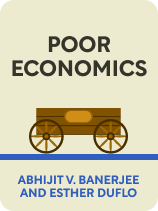

This article is an excerpt from the Shortform book guide to "Poor Economics" by Abhijit V. Banerjee and Esther Duflo. Shortform has the world's best summaries and analyses of books you should be reading.
Like this article? Sign up for a free trial here .
What is Esther Duflo and Abhijit Banerjee’s book Poor Economics about? What is the key message to take away from the book?
In their book Poor Economics, MIT professors Esther Duflo and Abhijit Banerjee analyze poverty by asking small, pointed questions about specific aspects of the lives of the poor. Their goal is to develop a detailed picture of how the poor live and how policy interventions affect their lives so that policymakers can better design interventions that help them.
Below is a brief overview of Poor Economics by Esther Duflo and Abhijit Banerjee.
Poor Economics
As of 2005, 13% of the world’s population lived on less than 99 cents per day. Development economists often try to design programs to alleviate this poverty by asking general questions and making unverified assumptions about the lives of the poor. Accordingly, their programs often result in few improvements to the lives of the impoverished.
In their book Poor Economics, Esther Duflo and Abhijit Banerjee approach the analysis of poverty differently: not by asking high-level, abstract questions, but by asking pointed questions exploring specific factors that affect the way the poor live. Economists at MIT, they founded the Abdul Latif Jameel Poverty Action Lab (J-PAL) to build on these techniques, and in Poor Economics, they share their insights.
In this guide, we’ll explore the main aspects of Duflo and Banerjee’s approach to analyzing poverty, which includes asking small questions about the lives of the poor and gathering data to develop an understanding of those lives. Next, we’ll see what the authors discover when they apply this approach to two specific aspects of poverty: the private lives of the poor and the markets and institutions that affect the poor. Finally, we’ll share four of the key insights Duflo and Banerjee offer based on this exploration.
Along the way, we’ll note critiques of their approach, and we’ll share relevant updates on the current status of global poverty.
(Shortform note: Banerjee and Duflo, together with their colleague from Harvard, Michael Kremer, won the Nobel Prize in Economic Sciences in 2019 for their work on this topic.)
Ask Small Questions to Gather Useful Data
The approach Duflo and Banerjee take to analyzing poverty involves asking smaller questions than are typically posed in development economics. Big questions are common in the field. For example, “Should other countries send resources to poor nations for free or give them the freedom to alleviate poverty on their own terms?” This is a broad question about aid versus freedom with no universally applicable answer.
Duflo and Banerjee suggest that such questions fail to uncover the nuances of the lives of the poor. Instead of asking, “Should aid be given for free?” we might ask, “How much do people use free insecticide-treated bed nets one year after they receive them, and how does this compare to the usage of full-price bed nets?” Breaking larger questions into smaller parts like this lets us make better observations that yield more useful information.
In Poor Economics, the authors draw on numerous sources of information to answer small questions and create a detailed picture of the poor that can support better policy decisions. Much of the information they present comes from studying evidence about the consequences of specific interventions, as well as from data compiled on the lives of the poor in 18 countries around the world. Duflo and Banerjee provide access to this data at www.pooreconomics.com.
Small Questions About the Private Lives of the Poor
In the following sections, we’ll discuss some of the conclusions the authors reached by asking small questions about the behaviors and habits of the poor in their private lives. We’ll explore why the poor are malnourished, how they interact with their healthcare resources, why their schools are failing them, and how they plan—or don’t plan—their family size.
Why Are They Malnourished?
Duflo and Banerjee discuss a well-known problem among the poor: malnutrition. They assert that policymakers assume the poor are malnourished because they don’t get enough calories, either because they can’t afford to buy enough food or because not enough food is available. For this reason, many programs focus on getting more calories to the poor in the form of carbohydrate-based staples, like rice.
However, Duflo and Banerjee believe this approach is misguided: In reality, the poor don’t need more food—they need more nutritious food. The evidence shows that even when the poor have easy access to calories, they still often suffer from malnutrition because many of the foods they eat lack key micronutrients. This leads to health issues.
The authors thus argue that access to nutritious food is less of an influence on the nutritional decisions of the poor than other reasons which lead them to make less-than-ideal choices about food, including:
1. They don’t know how important good nutrition is. Duflo and Banerjee argue that the poor haven’t been educated about nutrition in the way people in rich countries have: They simply don’t know how important micronutrients are and therefore don’t go out of their way to purchase fortified foods even when they’re available.
(Shortform note: Researchers have found that educating mothers of young infants on proper child nutrition resulted in improvements in the infant’s nutritional status. Results like this indicate that information is an important component of reducing malnutrition.)
2. They eat based on taste. Like most people, the poor prefer foods that taste good to them, write Duflo and Banerjee. Much of this food consists of simple carbohydrates, such as rice, processed grains, and sugar—all of which provide little nutrition. The poor aren’t inclined to eat something nutritious if they don’t find it tasty.
(Shortform note: Scholars argue that altering people’s eating preferences is an important way to improve global nutrition. They see three main avenues for changing consumer diets: First, make healthy food more appealing by labeling it attractively or making it cheaper through subsidies, for instance. Second, make it easier to get healthy food by making more such foods available or by displaying them more prominently. Finally, make healthy eating socially normal, as opposed to countercultural, by, for instance, not separating healthy foods from unhealthy ones. A combination of such approaches can go a long way toward changing people’s dietary habits.)
3. They prioritize other aspects of their lives over nutrition. Duflo and Banerjee find that the poor often willingly scrimp and save for non-food items like TVs but don’t make smaller sacrifices to ensure they get healthier foods. They believe the poor value diversions and entertainment because their daily lives are monotonous and hard—they need something to look forward to.
(Shortform note: Some economists argue that using entertainment to drive behavioral changes is an effective way to improve the lives of the poor. In particular, they note that the internet and TV are good ways to deliver important information, show good role models and affect people’s preferences, and direct how people use their time.)
According to Duflo and Banerjee, these are the reasons why the poor are malnourished—the common belief that the poor simply can’t eat enough food to be healthy is mistaken.
Why Don’t the Poor Take Advantage of Effective Healthcare Resources?
Many affordable and effective healthcare resources are available to the poor, yet they don’t use them as much as they should, claim Duflo and Banerjee. The authors highlight four factors affecting the poor’s approach to their healthcare.
The Poor Aren’t Served Well
Trained government healthcare professionals are frequently absent from clinics close to the homes of the poor, assert Duflo and Banerjee. Even when they are present, they give the poor little attention. As a result, the poor often abandon the effective resources available at regulated clinics and seek care from independent providers. Many of these providers are unregulated or have no training. As a result, they often cause more harm than good by, for instance, reusing unsterile needles and spreading blood-borne diseases or by overprescribing antibiotics and increasing antibiotic resistance. Nevertheless, since they’re generally present to offer services, the poor continue to seek out the care of these independent providers, despite the harm they can do.
(Shortform note: Researchers find that healthcare worker absenteeism in low- and middle-income countries ranges between 17% and 48%. One study found that, among all types of healthcare providers (private and public), absenteeism was accepted as the norm. For this reason, the poor often must take matters into their own hands and seek out whatever care they can get.)
The Poor Are Uneducated About Health
According to Duflo and Banerjee, most of the world’s poorest people aren’t educated—they haven’t had high school biology and in many cases, they’re illiterate. Further, accurate, up-to-date information about healthcare isn’t widely available in many places. For these reasons, the poor often end up making uninformed decisions about their health that lead to bad outcomes.
Because they’re uninformed about effective treatments and because, as mentioned above, their health care providers are also often uninformed, the poor tend to rely on their gut, favoring treatments that feel like they should be effective, assert Duflo and Banerjee. This often means they prefer more dramatic treatments over simpler treatments, even if those simpler treatments are actually more effective and less dangerous.
For example, when seeking care for diarrhea, the poor often ask for antibiotic injections instead of a simpler oral rehydration solution (a drink consisting mainly of water, sugar, and salt), even though antibiotic injections are often less-effective and can lead to problems mentioned above, like drug resistance or the spread of blood-borne diseases. If they understood their health needs better, the poor would be less apt to make such a mistake, claim Duflo and Banerjee.
(Shortform note: Other experts have likewise noted that many in the world’s poorest countries have low health literacy: They have difficulty finding, reading, understanding, and using information about healthcare. Experts note that increasing health literacy among the poor isn’t just a matter of educating individuals in basic reading, writing, and math skills—it’s also a matter of educating community health workers, researchers, and governments on the most effective ways to communicate with the people they serve.)
The Poor Are Extremely Sensitive to Price
Even minimal costs can discourage the poor from using effective preventive tools such as bed nets, contend Duflo and Banerjee. For example, experiments have shown that the poor are far less likely to get bed nets if they’re not free—even if they’re available at prices well within their means. Often, these cheap technologies are the only things preventing the spread of disease, so it’s a problem that the poor are unlikely to spend money on them.
(Shortform note: Duflo and Banerjee’s Poverty Action Lab conducted 10 evaluations in four countries to determine how changes in price affect the poor’s use of preventive technologies, including the bed nets they mention in the book. They found that usage fell dramatically when products once offered for free were offered at a small price. For example, in one case, free deworming treatment was discontinued and offered instead for $0.30. This fee was well within the means of the poor to whom it was offered, yet usage of the treatment fell from 75% to 19%. The results were similar in all cases.)
The Poor Don’t Take Advantage of Preventive Measures
Duflo and Banerjee believe this isn’t a phenomenon that’s unique to the poor: Humans often don’t take small preventive measures today that can avert larger problems in the future. For this reason, the poor often don’t take advantage of preventive measures like vaccines that can save them from contracting diseases down the road.
(Shortform note: Researchers find that the poor take advantage of preventive measures more if they’re given a small incentive, such as a little bit of food or a very small sum of money. They suggest that such small incentives work to overcome procrastination in the poor by giving them a reason now to act on something they know they should do anyway.)
According to the authors, these dynamics account for why the poor fail to take advantage of the resources that already exist to maintain and improve their health—thus, if policymakers hope to take steps to improve the health of the poor, they need to factor them into their efforts.
Why Aren’t Schools Alleviating Poverty as Well as They Could?
Duflo and Banerjee also argue that schools in the developing world often don’t help the poor as well as they could. Teacher and student absenteeism is high and students are far behind in reading and math. Based on their research, the authors believe that the key reason schools fail so many poor students is that people have wrong expectations about who education is for and what it’s supposed to accomplish.
Poor parents expect education to result in a well-paying job for their children, write the authors. However, because there are few well-paying jobs in their areas, they tend to only educate the one or two children they feel are most likely to land such a job. Parents don’t bother educating the rest because they don’t see the value of teaching their kids basic literacy and numeracy skills unless it results in a coveted local job.
(Shortform note: In most developing countries, the jobs with the most security and best wages are government jobs, which often pay several times the average local wage. However, these jobs are scarce, and in some places only open to those who pass a competitive exam. For this reason, government jobs are highly sought-after, but it’s very difficult for the average person to get such a job.)
Unfortunately, this attitude means most children end up at a disadvantage in whatever jobs they eventually land, continue Duflo and Banerjee. Studies show that even farmers benefit from having basic education levels.
(Shortform note: Researchers examining the relationship between crop yields per acre and farmer education level found that farmers with the equivalent of a high school education had yields nearly twice the size of farmers with no education.)
Further, the tendency to focus education only on an elite group of intelligent and talented children means that the kids who need education the most—those with fewer natural advantages—aren’t getting it, assert Duflo and Banerjee.
Therefore, no real progress can be made on improving education for the poor until the problem of wrong expectations is addressed.
How Do Poor Parents Plan Their Family Size?
Based on their research, Duflo and Banerjee found that poor mothers often suffer disadvantages if they have children too early in life or if they have more children than they can afford. If they have children before they finish school, mothers tend to get less education during their lifetimes, and if they have more children than they can afford, mothers sacrifice their own nutritional and health needs to ensure those children are cared for. Mothers with less education and poorer health in turn have a harder time escaping poverty.
(Shortform note: Girls who receive more education are more likely to delay pregnancy and earn a higher income later in life. Experts find that for every year a girl in a developing nation is in school, her first pregnancy is delayed by six to 10 months. Also, for every year of secondary education a girl completes, her income grows by 15 to 25%. Statistics like this suggest that enabling girls to stay in school is a powerful way to reduce poverty.)
Given these facts, Duflo and Banerjee wanted to determine how the poor make decisions about their fertility. They found that two factors affect these decisions:
Disempowered Women Can’t Make Independent Decisions
Poor women are often disempowered, which renders them less able to make independent decisions about their fertility. Specifically, poor girls are often less educated than boys and have fewer employment opportunities. They thus frequently see motherhood as the only way to achieve economic security: After all, the father may support them. According to Duflo and Banerjee, this encourages girls to engage in risky sexual behavior even before they’ve finished school, which leads to early pregnancies.
Evidence suggests that when empowered and allowed to decide for themselves, poor women prefer to have fewer children than when their decision is influenced by their husbands. Women who were given unaccompanied access to family planning services reported fewer unwanted pregnancies than those who accessed those same services with their husbands, claim the authors.
(Shortform note: Since the publication of Poor Economics, more studies have confirmed the authors’ findings that when women are empowered to make their own decisions, they choose to have smaller families. A recent policy intervention in Uganda found that providing teen girls with vocational training and information on reproduction and marriage led to lower rates of teen pregnancy and early marriage four years after the intervention. They further expressed a desire to marry and have children at a later age than did their peers and were nearly 50% more likely to be generating independent income, suggesting a causal link between financial independence and the decision to have fewer—and later—children.)
Parents View Children as a Form of Economic Security
Duflo and Banerjee also argue that in countries lacking institutional support such as retirement funds and health insurance, parents rely on adult children for care. For example, in places where fertility rates are forced down, savings rates go up, indicating that parents view children as a form of savings, so that when they have fewer children, they purposefully put aside more savings for the future because they assume they’ll have fewer children supporting them in old age. This was seen, the authors say, when the Chinese government initiated a program of family planning: As average family size decreased, savings rates gradually increased.
If policymakers want to improve the lot of women and parents and help them make good fertility decisions, they need to address the above two factors, assert Duflo and Banerjee.
(Shortform note: Although Duflo and Banerjee argue that when parents have fewer children, they’re more motivated to save money, they don’t address the possibility that increased savings in smaller families might be a result of children simply being expensive, so that when parents have fewer kids, they consequently have more money to set aside for the future. Researchers found that the average cost of raising a child to age 18 in China was nearly seven times a family’s average annual income. The authors don’t explore whether larger savings are caused by smaller families or are merely correlated with them.)
Small Questions About Markets and Institutions That Affect the Poor
According to the authors, the private lives of the poor are influenced by market and institutional forces. In this section, we’ll explore the factors that shape these forces, and we’ll discuss how they affect the poor.
Why Do Financial Services Not Help the Poor?
Wealthy people benefit from financial services, such as comprehensive insurance and easy-to-access credit, assert Duflo and Banerjee. Despite the fact that the poor also need these services, businesses rarely provide them.
Insurance Companies Offer the Poor Few Options
Duflo and Banerjee argue that the poor have a strong need for insurance because they’re exposed to more and greater risk than the wealthy: Their jobs (often in agriculture or casual labor) are unstable, they’re more vulnerable to disease, and they endure violence more often. Living on a knife’s edge of financial security, the slightest setback can be catastrophic for the poor.
(Shortform note: This factor—the lack of security in the lives of the poor—is known as low socioeconomic resilience, and it’s one reason why the poor are disproportionately affected by natural disasters or extreme weather events. Because the poor don’t have the funds to easily replace assets lost in a disaster, they’re less resilient to such losses.)
However, insurance companies are reluctant to insure the poor because they find it unprofitable, write Duflo and Banerjee. The same general challenges insurers always face are amplified in the case of the poor: fraudulent claims, the tendency of the insured to take risks or run up costly medical bills, difficulty collecting payments, and so on. Insurers therefore offer limited options to the poor that tend to only cover catastrophic events. Duflo and Banerjee find that the poor don’t use even these limited options, for two main reasons:
1. They don’t trust the insurers. Insurance is based on paying for something you don’t yet need. This is a dynamic built entirely on trust—if the poor don’t know the insurers, it’s hard to grant them that trust.
(Shortform note: Experts agree that trust is one of the key factors that affect getting insurance to the poor. They suggest that one of the best ways to establish trust is through the demonstration effect: Make all insurance payouts public and easy for others to see and understand.)
2. It’s hard to plan for the future. This is the same issue keeping the poor from using preventive measures in healthcare, write Duflo and Banerjee. It’s hard for anyone to contemplate the future, let alone a catastrophic future, and it’s especially difficult for the poor to do so under the unrelenting pressure of a hardscrabble life.
(Shortform note: Researchers find that poverty causes short-term thinking. Scarcity, they say, changes what people pay attention to and causes them to focus more on short-term benefits than long-term costs. For the poor, then, the benefit of avoiding a payment in the present can loom larger than a potential future catastrophe.)
According to Duflo and Banerjee, the poor devise ways to minimize risk and informally insure one another—for instance by giving money to family and friends who fall on hard times or by borrowing from local (exploitative) moneylenders to pay unexpected health expenses—but these workarounds don’t provide the security formal insurance can, and they often lead to more debt.
(Shortform note: Nearly a quarter of all households in low-income countries borrow money to cover unexpected expenses. Interest rates on these loans vary considerably depending on who provides them, but researchers have found money lenders charging rates as high as 96% per year. Poor borrowers in these situations rarely escape their debt and often end up borrowing more money to pay off previous debts.)
So, development economists need to work on expanding insurance for the poor and improving their general circumstances to help them manage the risks they face in life, argue Duflo and Banerjee.
The Poor Have Limited Access to Credit and Loans
Banks are unwilling to give the poor access to loans and credit because doing so is unprofitable—it’s expensive to verify creditworthiness, and there’s always the possibility of default, explain Duflo and Banerjee. To cover their expenses and justify the risk of lending to the poor, banks only offer them lending options with extremely high interest rates. These are hard for the poor to pay back, so they rarely seek out a loan or a line of credit from a bank.
(Shortform note: Researchers estimate that about three quarters of the world’s poorest people don’t use banks.The chief reasons for this are travel distance, bureaucratic barriers, and high costs.)
Because of this, innovators have developed a new kind of institution to lend to the poor, write Duflo and Banerjee: the microfinance institution (MFI). MFIs lend small sums of money at affordable interest rates to those who don’t otherwise have access to formal credit. Economists have praised these institutions for using innovative strategies to accomplish this profitably, and many policymakers have assumed that MFIs have solved the problem of getting credit to the poor. However, Duflo and Banerjee don’t believe MFIs have been as beneficial to the poor as their reputations suggest.
The authors observe that two core strategies MFIs use to lend to the poor actually end up discouraging them from using MFI loans to significantly improve their lives:
1. MFIs lend a sum of money to a group of borrowers who are all mutually accountable for repaying that sum. If a group member defaults or misses a payment on their equal portion of the sum, the other members have to make up the difference, explain Duflo and Banerjee. This is good for MFIs because the borrowers do the work of vetting each other and collectively ensure that the loan gets repaid. The trouble is, many poor people are unwilling to enter into this kind of an agreement if they don’t know the other people in the group well and can’t be sure everyone’s going to repay their debts on time—it puts them at risk of having to take on other people’s debts as well as their own.
(Shortform note: In the time since the publication of Poor Economics, the microfinance industry has grown considerably, and group-lending is no longer the only way MFIs lend to the poor. Studies have shown, in fact, that when MFIs offer individual loans, they attract more new borrowers. This indicates that potential borrowers are indeed, as Duflo and Banerjee suggest, reluctant to join a group to get a loan.)
2. MFIs don’t offer flexibility in how their loans are repaid. They impose a strict repayment schedule, typically demanding that regular payments are made by the borrowing group on a weekly basis, write Duflo and Banerjee. This, again, is good for the MFI, but discourages the poor from borrowing money if they feel unsure about when they can start paying it back. For instance, if a laborer is injured, she may be unable to get back to work and earn money for a long time. Duflo and Banerjee say it also discourages people from taking larger loans that would bring more benefits but would take longer to repay—for example, someone might want to buy a cart to sell fruit, but can only afford to borrow enough money to rent the cart for the day to make the weekly payments.
(Shortform note: MFIs have become notorious for their inflexible repayment structures. Borrowers are often subjected to public shaming and humiliation for missing payments or defaulting and suffer severe psychological stress.)
For these reasons, the authors find that the poor often avoid using MFIs to cover important expenses. Instead, they prefer to borrow from family and friends because of the flexibility they have in repaying those loans. Given this lending landscape, the poor have difficulty borrowing enough money to make significant changes in their lives. So, there’s still work to be done in figuring out how to get the poor enough credit to improve their lot.
The Poor Rarely Save for the Future
Duflo and Banerjee find that, even on their meager incomes, the poor don’t save as much money as they could. The evidence suggests this is true whether the poor have access to formal savings accounts or not. The two main reasons the authors find for this inability to save are:
1. Setting aside money requires self-control and decisiveness—the poor struggle with this because of their stressful lives. Stress, the authors point out, damages our ability to make decisions and exercise self-control. Because the poor always live under significant stress—they endure a lot of risk and barely have enough resources to cover daily needs—their brains can’t easily control impulses and plan for the long-term.
(Shortform note: Studies confirm the authors’ point about poverty’s effect on self-control. Researchers suggest that giving the poor money or other assets improves their ability to regulate their decisions and save for the future.)
2. Setting aside money requires feeling hopeful about the future, but the poor often feel hopeless because the possibility of a better future seems unrealistic. Too often, the authors find, the poor’s best efforts to save for the future are negated by unexpected health expenses, crop losses, or other disasters. As a result, the poor rarely believe they’ll reach any goal they hope to save for.
(Shortform note: Hope has been demonstrated to increase savings rates. Hope enables people to focus on the future, making it easier for them to take actions now that will improve that future.)
These reasons are primarily internal and psychological, but the authors see them as nonetheless relevant to explaining why the poor don’t set aside enough money to ensure more financial stability in the future. Policymakers need to account for this if they hope to increase savings rates among the poor.
(Shortform note: Affecting the way the poor think about savings may be as simple as giving them a lockbox. A recent study of poor small-business owners in Malawi demonstrated that poor entrepreneurs given lockboxes saved more money than those who weren’t given any. In addition, those with lockboxes ended up spending more money on school-related expenses, giving gifts, lending money to friends and family, and giving credit to their customers. The study suggests that even simple, affordable interventions can make a difference in the savings and spending habits of the poor.)
Why Do They Run Businesses?
According to the authors, many poor people run their own businesses. Most work in agriculture as fruit vendors or farmers, for instance. Many westerners see this as evidence of a natural entrepreneurial spirit, but Banerjee and Duflo disagree. They’ve found that the poor generally run businesses only because they have no other options: The job market has failed them.
In their research, Duflo and Banerjee noticed that the businesses of the poor are typically small and unprofitable, even though they have a high marginal return. This means that it would take little money to grow their businesses. Despite the high marginal returns, the poor generally choose not to invest in their businesses.
As the authors see it, this seems to be because the poor don’t want to run a business—they don’t want to be entrepreneurs. Instead, in all the countries Duflo and Banerjee examined, the poor almost universally aspire for their children to get the only kind of stable job they know of: a government job. The small businesses they run are just a means of getting by until that happens.
So, instead of celebrating the supposed entrepreneurial spirit of the world’s poor, development economists need to figure out better ways to get the poor stable jobs, assert Duflo and Banerjee.
4 Key Lessons About Improving the Lives of the Poor
Banerjee and Duflo set out to examine the lives of the poor as they actually are. They see several key lessons emerging from this study. In this section we’ll share four of those lessons, as well as the authors’ suggestions for addressing them.
The Poor Need More Information
When it comes to personal or economic decisions, the poor often simply don’t have enough information to make good choices, believe Duflo and Banerjee. To get more information to the poor, it should be delivered in enjoyable formats, such as through song or a funny advertisement, and it should be delivered by sources the poor find credible, like the press or local, trusted people.
(Shortform note: A recent study shows that, in trying to get information to the poor, policymakers should carefully consider the message, the medium, and the messenger. Duflo and a team of researchers conducted a randomized controlled trial in India and the United States to determine the effectiveness of using social media to deliver information directly to the poor. They found that messaging delivered via Facebook worked best when it was presented in simple terms by a celebrity—not by an official appointed as an expert.)
The Poor Need Easier Choices
Wealthy people living in wealthy countries have many difficult decisions made for them, which benefits them because they then don’t have the opportunity to make poor decisions, claim Duflo and Banerjee. Their water is purified, their healthcare providers are highly trained and closely regulated, their foods are fortified with key nutrients and regulated to ensure they’re safe, their assets are protected, they have money set aside for the future through Social Security or other financial institutions, and so on.
The poor have none of these things, write the authors. They have to purify their own water, figure out ways to save for the future outside of typical financial institutions, make complicated decisions about their healthcare, and more. Such decisions are difficult for anyone to make, but especially for the poor, who feel the constant pressure of a lack of resources, information, and basic economic security.
Duflo and Banerjee suggest that a practical way to alleviate this pressure is to make these decisions easier for the poor. One way to do this is by ensuring default options are good. If tasty cereals are fortified and made readily available, it’ll be easier for the poor to get critical micronutrients into their diet. Referring to Richard Thaler and Cass Sunstein’s book, Nudge, Banerjee and Duflo propose a second way to make good decisions easier for the poor: Nudge them toward the right choices. For example, savings accounts could be structured to encourage deposits and discourage withdrawals.
The Poor Need Innovators and Governments to Build Better Financial Services
Duflo and Banerjee argue that governments, charitable organizations, and private financial groups can and should develop innovative financial services for the poor. Where electronic money transfers have become available, for instance, the poor have more access to funding. Though microcredit financing has its limitations, it has made credit more available to even the poorest people.
In certain situations, the authors believe governments should step in with subsidies or other financial incentives to help provide adequate services to the poor. This applies in cases where free market forces don’t support the development of services the poor need. Health insurance options for the poor, for example, tend to cover only catastrophic events and not preventive care. Duflo and Banerjee argue that in cases like this, the benefits of offering free goods and services—such as bleach or routine check-ups—often outweigh the costs.
The Poor Need Improved Expectations
Expectations can become self-fulfilling, write Duflo and Banerjee. Accordingly, when parents, teachers, politicians, or the poor themselves expect failure, they get failure. However, policymakers can take measures to change expectations. For instance, when women were given leadership roles in rural India both men and women began to see women as potential leaders.
Duflo and Banerjee argue that giving things away for free can help improve people’s expectations for their own lives. In their view, a change in circumstances for the better tends to give people hope for the future. Renewed hope can change the way people think about the present, which initiates a virtuous cycle.

———End of Preview———
Like what you just read? Read the rest of the world's best book summary and analysis of Abhijit V. Banerjee and Esther Duflo's "Poor Economics" at Shortform .
Here's what you'll find in our full Poor Economics summary :
- A look at how some people live on less than 99 cents per day
- An analysis of how the poor live and how policy interventions affect their lives
- The four key insights Duflo and Banerjee offer about poverty






